You
can also view the message online

Châtenay-Malabry (FR - 92290), June 13, 2022
EFITA newsletter / 1043 - European Federation for Information Technology in Agriculture, Food and the Environment
The informatique-agricole.org site offers you the possibility of subscribing the RSS feeds of its two newsletters
See RSS feeds to implement to ensure that you continue to receive this newsletter
To unsubscribe this newsletter, please contact me directely: guy.waksman(a)laposte.net if this link Unsubscribe does not work.

To correspond with me (GW), please use this address: guy.waksman(a)laposte.net
To subscribe the efita newsletter (please ask your friends and colleagues to test this link)
Efita Newsletters subscription
Avant l’informatique
June 15, 11am EST: Building a resilient global ag industry in the wake of Russia's invasion of Ukraine Join us on LinkedIn!
Feat. Yulia Poroshenko - AgroHub, Jim Henegan - Gro Intelligence, Himanshu Gupta - ClimateAI, Helena Wright - FAIRR, Maryna Kuzmenko - Petiole, Dymtro Lennyi - Intellias
See LinkedIn
European Congress of Precision Agriculture 2023: "Unleashing the potential of precision agriculture"
2-6 July 2023, BOLOGNA (IT)
>> Unleashing the potential of PA:
- Spatial & temporal variability in the growing & management of crops in fields, orchards, plantations, vineyards and the like
- 2nd wave - adoption in small farms
>> Topics
- PA general
- PA in crops
- Machinery for PA
- Software for PA
- Observation & measurement applied to PA
- Data & Image Analysis applied to crop management
- Biometry applied to PA
- Environmental monitoring applied to PA
>> Contribution
- Preliminary selection: double-blind peer-review (min 2 reviewers) of abstracts, maximum length 1-2 pages. Conference papers
- Oral presentations: double-blind peer-review of manuscripts, minimum-maximum length 5-8 pages, to be published both in print and online.
- Poster presentations: review by the scientific committee, poster + manuscript (maximum length 4 pages), to be published only online.
>> Publication: Proceedings books published by Wageningen Academic Publishers• Indexed in Scopus
>> Deadlines:
- Call for papers: June 1, 2022
- Abstract: October 31, 2022
- Acceptance: November 30, 2022
- Paper submission: December 31, 2022
- Reviews: February 28, 2023
- Final contributions: April 30, 2023
https://www.informatique-agricole.org/wp-content/uploads/2022/06/Ecpa_Bologna_2023.jpg
http://ecpa2023.it/
See ecpa2023.it
Weekly newsletters about ICT in Agriculture in English and French
Both newsletters have around 14000 subscribers.
>>> Last weekly EFITA Newsletters in English (created in 1999) Efita Newsletters
>>> Last weekly AFIA Newsletters in French (created more than 20 years ago in 1997) Afia Newsletters
>>> Statistics for the last efita newsletter
>>> Last issue of the afia newsletter
>>> Last available satistics for the afia newsletter
Calves, by John Alfred Arnesby Brown (1866–1955), Norfolk Museums Service
| 01 - 09/06/2022 | 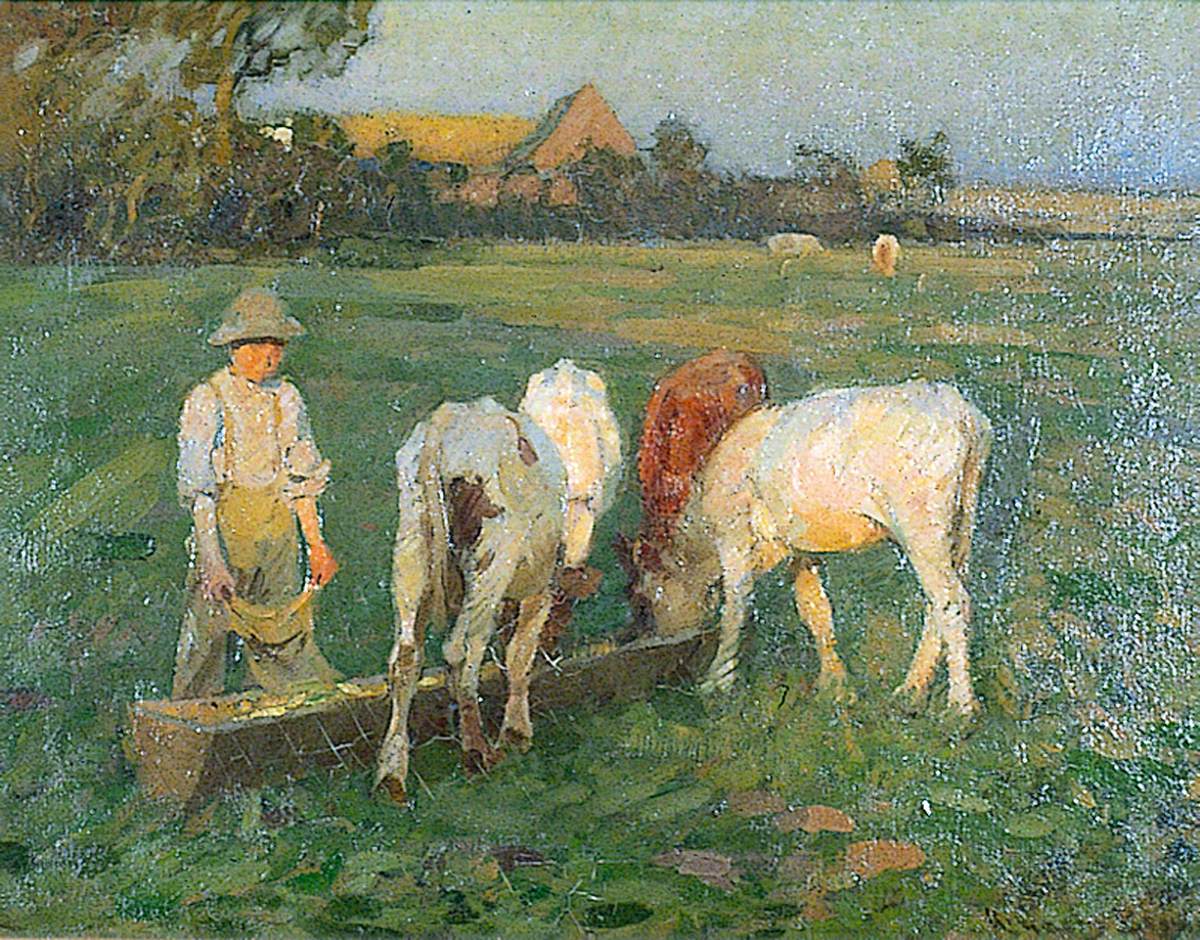 |
How to support agriculture in Ukraine to prevent a global food crisis, AFN, by Dmytro Lennyi
Russia’s war against Ukraine puts global food supplies at risk. Military actions in Ukraine’s north, south, and east have reduced the amount of land that farmers can sow. Additionally, Ukrainian export routes through the Black Sea and Azov Sea are blocked, and roads and railways are damaged. While Ukraine may still meet its own demand for food this season, countries that depend on Ukrainian exports of food products will experience shortages.
I’ve studied the Ukrainian agricultural market for years, and I’ve received many questions and concerns about the current situation. Now, I want to address the most commonly asked question: What can we do to help Ukraine and prevent a global food crisis?
>>> What’s at stake?
Ukraine is the fourth largest agricultural exporter in the EU. It’s a global provider of barley, corn, and wheat. Last year, Ukraine provided 12.8% of total global corn exports and 10.5% of wheat exports. It’s also the largest exporter of sunflower oil. In 2021, Ukraine received 40% of worldwide revenue for sunflower oil exports.
Unfortunately, the country’s 2022 sowing season, which started at the end of March, has seen only 6 million hectares sown (80% of last year’s area). In addition, the blockade of Ukrainian ports has reduced Ukraine’s ability to deliver grain. Ukraine is now deprived of all water connections with the world through which it used to deliver the majority of its exports. According to deputy minister for digital transformation Taras Dzoba, Ukraine can now deliver just 300,000 metric tons of commodities per month, whereas it used to deliver 4.5 million tons.
The UN World Food Program (WFP) sources almost half of its supplies from Ukraine. This means that canceled shipments from Odesa will affect West Africa and other countries at high risk of hunger. Afghanistan, Ethiopia, Syria, and Yemen all largely depend on Ukraine’s wheat through WFP food procurements.
.../...
See agfundernews.com
The Hayfield by John Alfred Arnesby Brown (1866-1955), King's Lynn Museums
| 02 - 02/06/2022 | 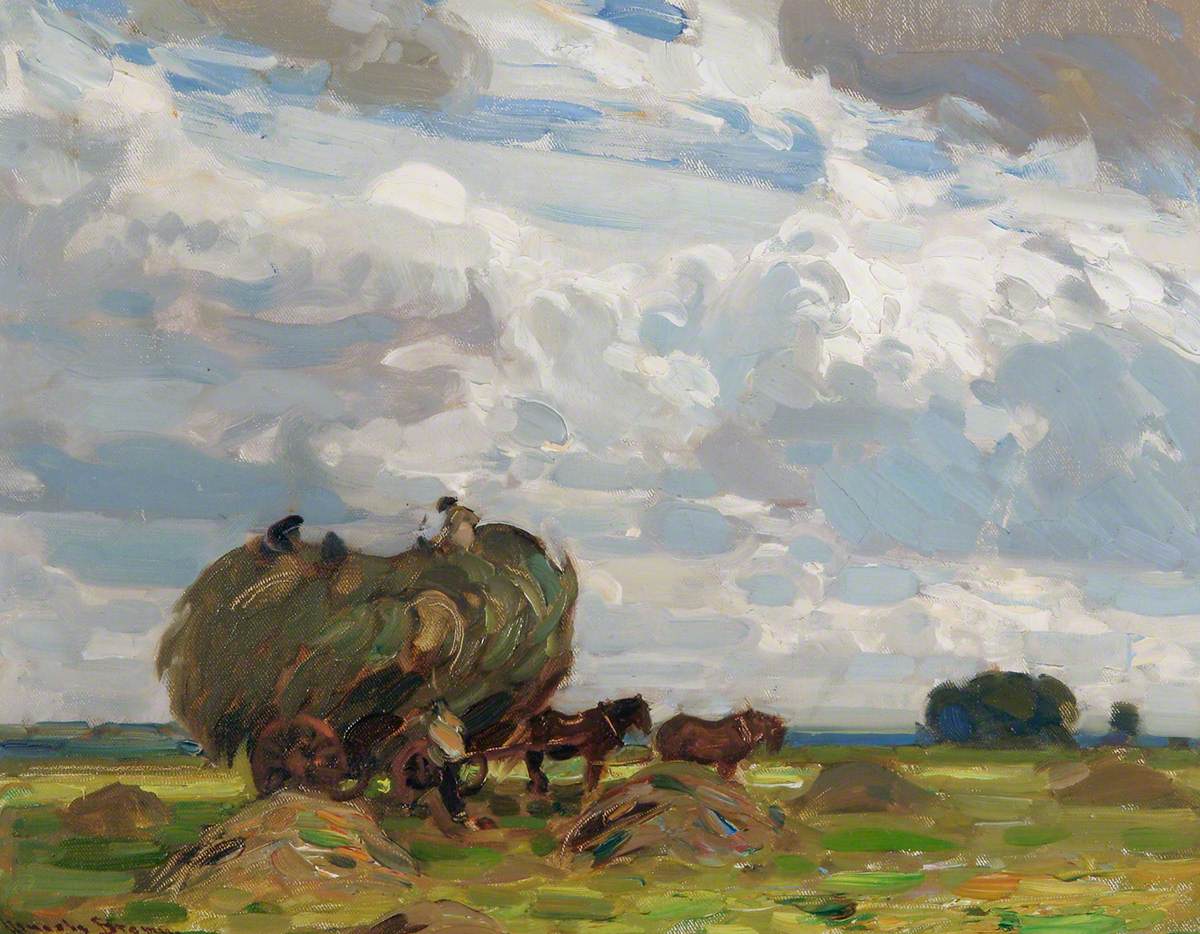 |
How did we see the future yesterday??
See the incredible collection developed by Alain Fraval
FutureFarming.com
> Pyka Pelican on doorstep of getting commercial approval in US
The fully autonomous Pelican crop spraying aircraft has now successfully completed the final stage of flight demonstration for commercial approval in the US. In May last year a Pelican took to the skies for the first autonomous fixed wing aerial application on a banana crop in the world.
https://www.futurefarming.com/app/uploads/2022/05/IMG_Pelican1.jpg
> Drones: Automated drones scare birds off agricultural fields
A Washington State University research team has developed a system where cameras could spot pest birds in vineyards or orchards and launch drones to drive off the birds, then return to watch for the next invading flock.
> Partner feature: Innovative seeding method increases yields
Michael Richardson is a farmer by conviction. The family has been running the dairy farm in the heart of Lancashire for four generations. His 150 cows are particularly close to his heart. With his 75 hectares of arable land, the farmer grows corn for his dairy cows, among other things.
> Weed control: Weedbot works faster and more accurate with Enot technology
Enot, a developer of neural network optimization tools, has partnered with Weedbot. Weedbot’s Lumina, which uses laser, can process imagery faster and with more accuracy thanks to Enot’s neural network optimization technology.
> Harvesting: Using harvesting platforms to broaden the workforce
Australian company R&;R Smith is using four harvesting platforms in its orchards. It opened up the workforce and improved the fruit quality in the bin.
> Weed control: FarmWise accelerates release of its weeding implement
FarmWise has raised US $ 45 million in a Series B funding round. The Californian robotics company is accelerating the release of its vegetable weeding implement Vulcan. FarmWise expects the first of its field demo with the implement Vulcan in the US will happen at the end of the American summer.
> Field robots: What’s new in our drone buying guide 2022?
Future Farming introduces ten new application drones in its drone catalogue this year. Drones are increasingly capable of performing more and more tasks in the field. It is clear that farmers are currently presented with an impressive range.
> Smart farming on DLG Feldtage event
The famous annual DLG Feldtage event will be held from 14 to 16 June 2022 on the site of the Kirschgartshausen Versuchsgut “experimental farm” near Mannheim, Germany. Organiser DLG (the German Agricultural Society) has prepared a programme with the theme “My crop production. My future.”
> Azurit brings more yield!
Due to the optimized space distribution the plant gets more nutrients, water and light. Thereby the precison seed drill Azurit has been proven to increase yield up to 4,5 %. Convince yourself of the advantages of the innovative precision seeding technology in the DeltaRow method.
> Kubota to launch fuel cell tractor in 2025
> E-robotiller field robot makes its public debut
> Lemken and Krone show autonomous field robot
> SenseSpray designed to remove complexity of spraying process
> Controlled Row Farming: Making a profit while promoting biodiversity
> Precise spray systems compared: Five ways to radically reduce chemical use
See futurefarming.com
Cattle on the Marshes, by John Alfred Arnesby Brown (1866–1955), Norfolk Museums Service
| 03 -09/06/2022 |  |
Agrotools Finalizes $21 Million Funding Round with a Focus on Expansion and Acquisitions
The funding will be utilized to expand business throughout the United States, Latin America and other regions.
See precisionag.com
Report: Advancing Automation Technology Could Help Vertical Farms Achieve Profitability
IDTechEx has identified automation as a key technology area that could help vertical farms reduce key costs.
See precisionag.com
Netafim Study Shows Corn Grown with Drip Irrigation Significantly Reduces its Carbon Footprint
Study demonstrates major benefits of drip irrigation for corn production amidst a major food security crisis and the challenges of climate change.
See precisionag.com
The Smug and Silver Trent, by John Alfred Arnesby Brown (1866–1955), Birmingham Museums Trust
| 04 - 09/06/2022 |  |
Unfold, Sustenir Partner to Create New Locally Grown Superfoods for Asian Supermarkets
The partnership will produce vertical farm plant varieties with better nutritional value and provide a higher yield for Sustenir’s operations in key Asian markets.
See precisionag.com
Israeli Firm AgroScout Shows the Impact of AI and Robotics in Agriculture
AgroScout software uses both AI and robotics to monitor crops in order to accurately plan processing and manufacturing operations.
See precisionag.com
Shaky e-Grocery dominates $9bn in European AgriFoodTech investing while climate tech lags, AFN, by Jessica Pothering
…/…
More than $9 billion dollars was invested in agrifoodtech ventures in Europe in 2021, according to the latest European AgriFoodTech Investment report from AgFunder in collaboration with F&A Next. [Disclosure: AgFunder is AFN’s parent company.]
But that big headline number begs the question: are investors backing the right things?
We are eight years out from the Paris climate accord deadline for preventing catastrophic global warming and climate change. Trillions of dollars in investment are needed annually to achieve Paris’ ambitious goals. Last year, just $630 billion was invested in climate change mitigation and adaptation worldwide.
In Europe, just $1.5 billion, or 16%, of agrifoodtech investment capital went into technologies that could potentially have a high impact on the food system’s climate footprint, according to new research undertaken by AgFunder in collaboration with Dutch state investor Invest-NL.
Given the agrifood systems’ contribution to global greenhouse gas emissions globally (around one-third depending on the citation), this small sum of climate-forward capital seems like nothing but a missed opportunity.
See agfundernews.com
Landscape with Church, by John Alfred Arnesby Brown (1866-1955), Bury Art Museum
| 05 - 02/06/2022 |  |
More than 1,500 startups mapped in report on Brazilian agrifoodtech innovation, AFN, by guest contributor Marcella Falcão
The Covid-19 pandemic rapidly accelerated technology development and adoption in Brazil’s agriculture sector, according to a new market map of the Brazilian agtech ecosystem.
The Radar Agtech Brasil map details 1,574 agtech companies in 33 categories and three field segments and its creators added a new company each day of the past 15 months; that’s 449 new companies in just over a year.
“Brazil currently has the most robust and decentralized movement of agtechs on the planet. The resiliency of the ecosystem was tested during the pandemic and passed with flying colors,” says Francisco Jardim, founding partner of SP Ventures, an agtech investor based out of São Paulo, Brazil that collaborated on the map.
For him, Brazil not only has a huge agricultural market, but it is expanding its competitive advantage with technological differentials that can solve local problems.
“Brazil is globally competitive and a serious contender in the majority of major agricultural commodities. Besides a growth opportunity, agrifoodtech has proven itself a defensive asset class as well; since the market performs well, even when the region is doing poorly,” Jardim says
…/…
See agfundernews.com
The size of the World population over the last 12000 years
| 01 - 09/06/2022 |  |
World population by region since 1820
| 02 - 09/06/2022 | 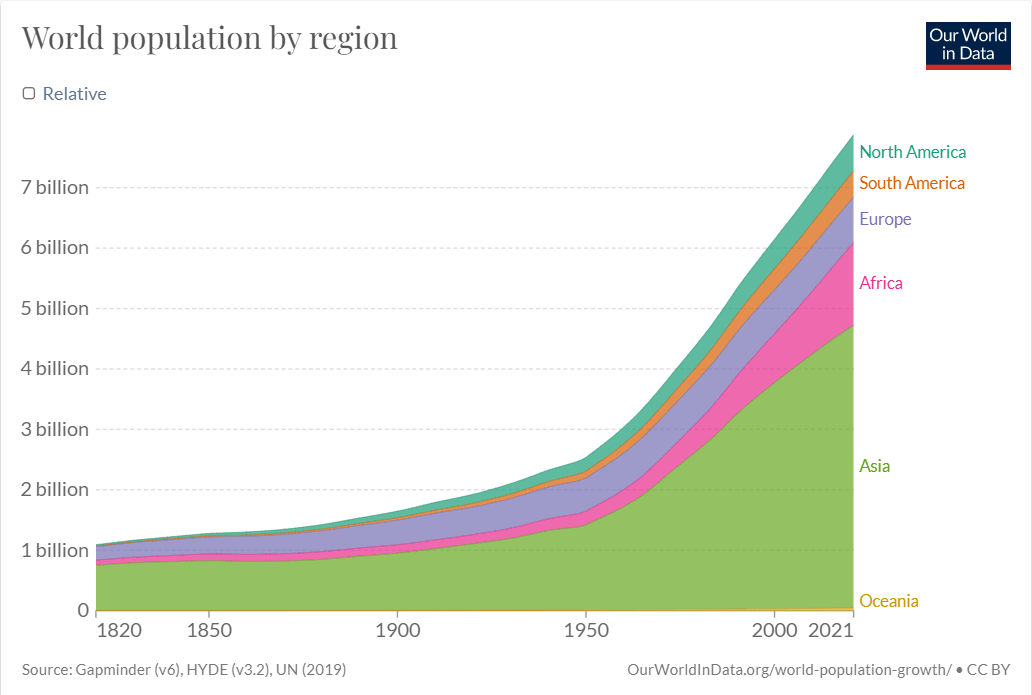 |
Covid-19 vaccine boosters administrated per 100 people
| 03 - 09/06/2022 | 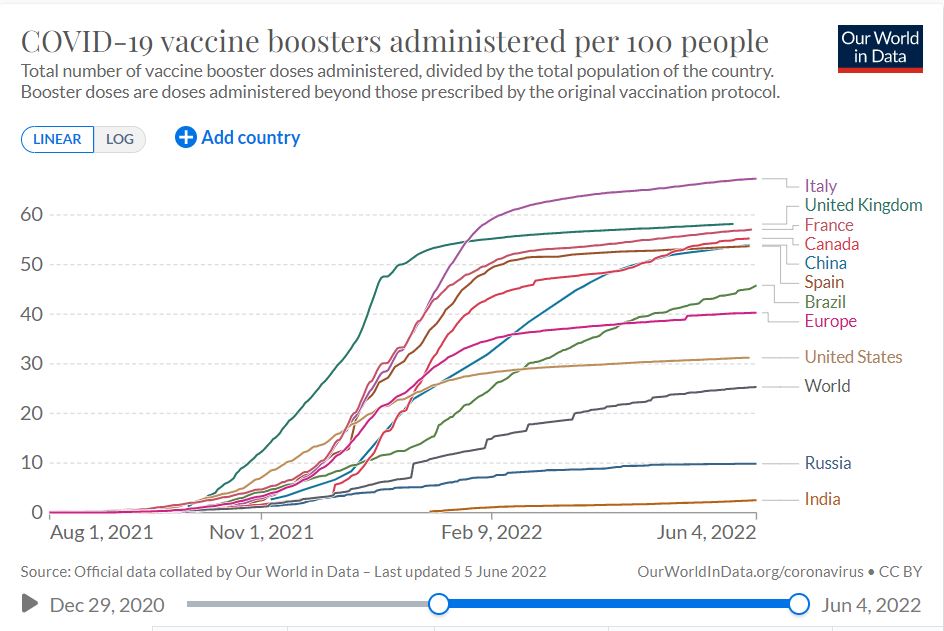 |
Covid cases and hospitalizations are rising again in the U.S.
| 04 - 09/06/2022 | 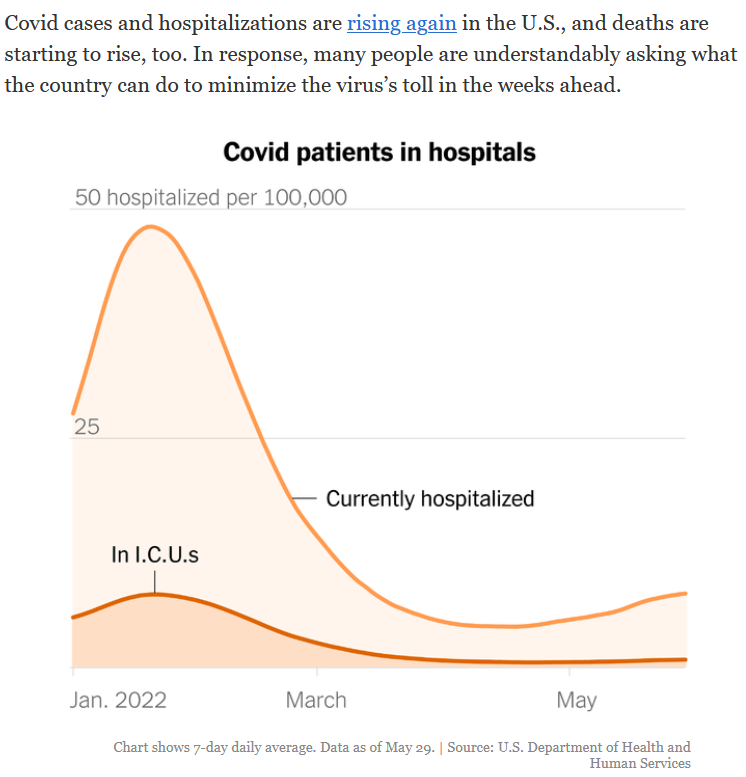 |
Farm robots will solve many of our food worries, Bloomberg, by Amanda Little
Machines bristling with cameras and controlled by artificial intelligence are bringing supernatural precision to weeding, harvesting and fertilizing.
.../...
Produced by John Deere and created by the startup Blue River Technology, these robotic weeders look much like standard industrial sprayers at first glance, but each is rigged with an intricate system of 36 cameras and a mass of tiny hoses. They use computer vision to distinguish between crops and weeds and then deploy with sniper-like precision tiny jets of herbicide onto the weeds — sparing the crop and ending the common practice of broadcast-spraying chemicals across billions of acres.
.../...
See bloomberg.com
FarmWise’s weeding robots haul in $45m Series B funding from Taylor Farms, others, AFN, by Jack Ellis
The FarmWise platform uses artificial intelligence, cameras, and sensors to generate a mass of “plant-level data” — including size, stress levels, and identifying features — which its fleet of Titan robots then relies on to differentiate between crops and weeds.
A set of robotic arms on the underside of each Titan unit then mechanically removes the weeds as they trundle across the vegetable field.
FarmWise claims that its platform’s plant database includes more than 450 million scanned images of individual crops collected over 15,000 commercial hours in the field.
See agfundernews.com
Hay Cutting on the Norfolk Marshes, by John Alfred Arnesby Brown (1866-1955), Great Yarmouth Museums
| 06 - 02/06/2022 |  |
US ag automation startup FarmWise Labs, which builds weeding robot Titan, has raised $45 million in Series B funding, it announced today.
- Fall Line Capital and Middleland Capital co-led the round.
- Taylor Farms, one of the top producers of leafy greens and other vegetables for the US retail market, and GV — the VC arm of Google parent Alphabet — came on board as new investors.
- Existing investors Calibrate Ventures, Playground Global, SVG Ventures, and Cavallo Ventures — the VC arm of Wilbur-Ellis — also participated in the round.
- The Series B raise takes the San Francisco-based startup’s total equity funding to date to $65 million.
…/…
See agfundernews.com
Overtime in the agriculture industry: One size can’t fit all, by Tim Durham, June 09, 2022
Overtime in the agriculture sector is a colossal misfire, and a glaring incompatibility if there ever was one for an industry that is anything by 9-to-5.
See agdaily.com
The Bridge, by John Alfred Arnesby Brown (1866–1955), Walker Art Gallery
| 07 - 09/06/2022 | 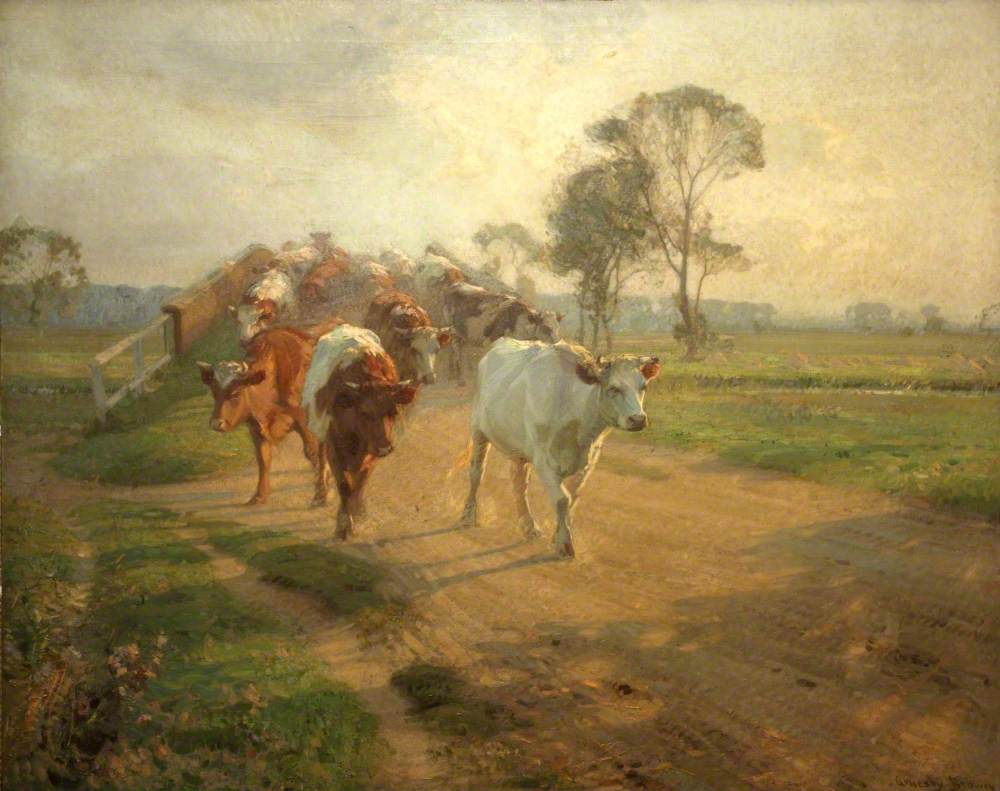 |
Does the growing of Bt maize change abundance or ecological function of non-target animals compared to the growing of non-GM maize? A systematic review, by Michael Meissle, Steven E. Naranjo & Jörg Romeis
.../...
>> Implications for policy
Our review provides evidence that Bt maize represents a highly selective pest control technology with relatively few negative consequences on a wide array of taxa associated with maize production, especially when compared with the alternative use of broad-spectrum insecticides for managing Bt-targeted pests.
The Bt maize transformation events that have been cultivated commercially worldwide have all gone through regulatory environmental risk assessments that concluded that no unacceptable risks for non-target organisms and biodiversity exist [2, 73, 74]. Our systematic review generally supports these conclusions.
>> Implications for research
Our results largely agreed with prior meta-analyses focused on or including Bt maize. The robust approach ameliorates many of the shortcomings of prior analyses, such as level of analysis, data-dependence issues, and consideration of internal and external validity.
One shortcoming of this current review and all prior ones, however, is the limited availability of appropriate data (in particular raw data) with the consequence that some data had to be estimated (rather than calculated) for the quantitative analyses, while other datasets could not be analyzed at all. Future articles should make full datasets publicly available to foster future meta-analyses and focus on taxonomic groups and geographies that are under-represented in the current database.
More research is recommended on experimental plot sizes necessary for a better representation of farm scale conditions for animals with mobile life stages and multiple generations per season. Furthermore, research on the biological relevance of differences in field populations is needed. For example, some evidence suggests small changes in abundance do not impact biological control function in Bt cotton [75].
That is, even if statistical differences in experimental studies and meta-analyses are observed, how are such differences linked to ecosystem functions and can they lead to harm?
See environmentalevidencejournal.biomedcentral.com
Does the Covid-19 crisis pave the way for less unbridled globalization?
Voir cepii.fr (in French)
| 05 - 09/06/2022 | 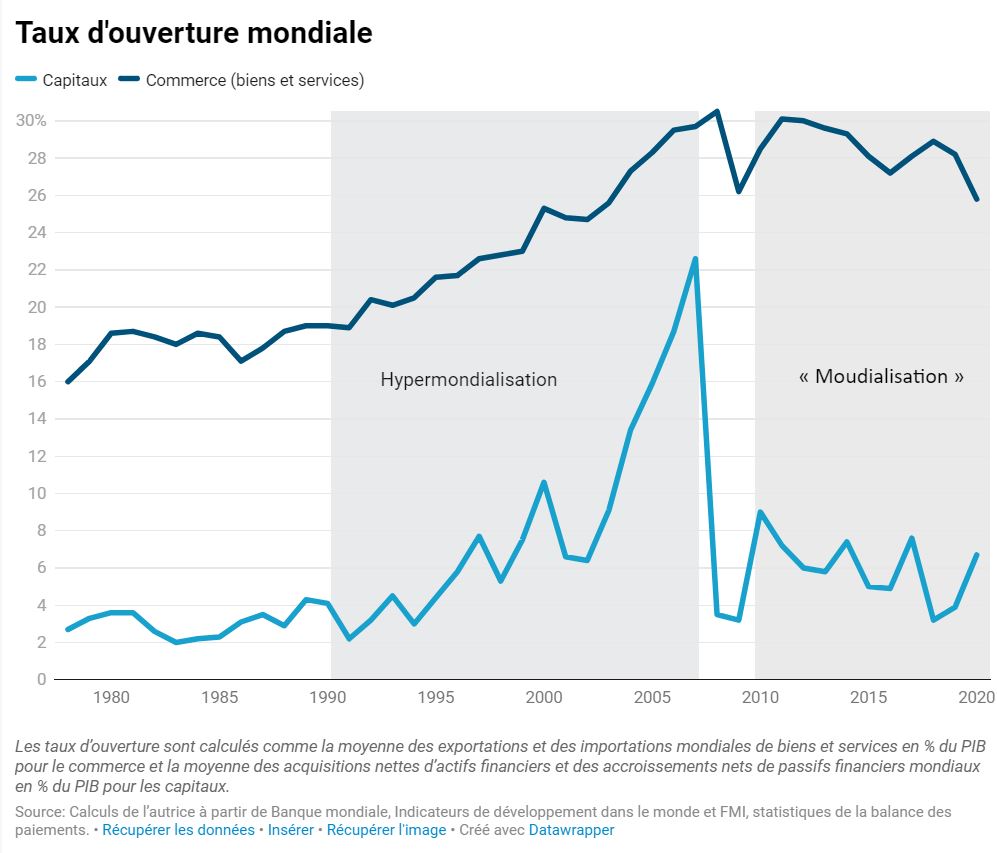 |
Personal food decisions are made when prices increase, by John Rigolizzo, Jr. May 12, 2022
I’m more than doubling the size of my garden this year.
We’re going to grow more of our own food in our backyard because I’m concerned about the cost and availability of fresh fruits and vegetables. As inflation soars, they’re going to become more expensive and harder to find.
That’s what my instincts as a lifelong farmer in New Jersey are telling me.
So I’m taking matters into my own hands. For years, I’ve grown tomatoes, peppers, cucumbers, and other vegetables in four garden beds behind my house. We eat them all summer and can them for the winter, making everything from tomato sauce to pickled peppers.
selective focus photo of shovel on sandNow I’m building an additional six garden beds. This will allow me to increase my tomato plants from 18 to 50 and my pepper plants from 24 to 60. I’ll also grow lettuce and eggplants.
../...
See globalfarmernetwork.org
Nobel Endeavours
Nobel Prize-winning physicist Richard Feynman once said ‘If you think you understand quantum mechanics, you don’t understand quantum mechanics.’ As people who’ve never professed to understand quantum mechanics, The Fence find this statement quite presumptuous, but decided we’d ask some of the world’s biggest boffins how much they do or don’t know about their jobs, life and everything else besides.
See the-fence.com/
“Carbon Bombs” - Mapping key fossil fuel projects, by Kjell Kühne, Nils Bartsch, Ryan DriskellTate, Julia Higson, André Habet
Global map of carbon bombs with combined potential emissions given for each country
See sciencedirect.com/
| 06 - 09/06/2022 |  |
After millennia of agricultural expansion, the world has passed ‘peak agricultural land’
For millennia humans have been clearing forests and wild grasslands to grow crops and raise livestock. This has come at a huge cost to the planet’s biodiversity.
But this expansion of agricultural land has now come to an end — we have passed the peak and global agricultural land use has declined.
Despite using less land for agriculture, the world has continued to produce more food than ever. This shows that feeding more people does not have to mean taking habitat away from other wildlife. We can produce more while giving land back to nature at the same time.
While this global picture is promising, there are several reasons why we should not be complacent about this development, such as the fact that agricultural land use is still increasing in many individual countries — often at the expense of carbon-rich habitats.
In this article, we make the case that the continued decline of agricultural land is not guaranteed. The future of land use rests on the decisions we make today.
Sketch for 'The Estuary, Gathering Clouds', by John Alfred Arnesby Brown (1866–1955), Norfolk Museums Service
| 08 - 09/06/2022 |  |
The argument for a carbon price
It’s a mistake to believe that we are not already paying for emitting greenhouse gasses. Even if we do not pay a monetary price for carbon emissions, we do pay a very large price: the consequences of climate change.
Without a monetary carbon price it is those who have the smallest emissions that suffer the largest costs from climate change. A carbon price, in contrast, means that those who cause the emissions also pay for them.
A key reason why voters are not in favor of carbon pricing is that many believe it won’t actually reduce emissions, but empirical research and theory show that this is wrong. Pricing carbon emissions — either via a carbon tax or a “cap and trade” system — is effective.
Many are deeply concerned about climate change yet feel hopeless that anything can be done to meet this challenge.
With this article from June 2021, we aim to increase the understanding that carbon pricing works, correct common misconceptions, and show that we have ways to successfully fight climate change.
|
Gazette
de vitisphere.com, |
Special thanks to Villanova University in Pennsylvania (USA) for its contribution to the realization of the Virtual Reality Tours of…
- Cappella Sistina
- Basilica di San Pietro
- Basilica di San Paolo fuori le Mura
- Basilica di San Giovanni in Laterano
Signalé par Georges LARROQUE
Mél : larroque.georges(a)orange.fr
Singapore national orchid garden: The largest display of tropical orchids in the world
The National Orchid Garden is located within Singapore Botanic Gardens. It is said to have the largest display of tropical orchids in the world. This amazing tropical garden became a UNESCO World Heritage Site in 2015.
See video
Glyphosate: no change proposed to hazard classification - ECHA/NR/22/10 - 30 May 2022
ECHA's Committee for Risk Assessment (RAC) agrees to keep glyphosate’s current classification as causing serious eye damage and being toxic to aquatic life. Based on a wide-ranging review of scientific evidence, the committee again concludes that classifying glyphosate as a carcinogen is not justified.
See echa.europa.eu
The Fight of Our Lives, by George Soros, May 24, 2022
DAVOS – Since the last Davos meeting, the course of history has changed dramatically. Russia invaded Ukraine. This has shaken Europe to its core. The European Union was established to prevent such a thing from happening. Even when the fighting stops, as it eventually must, the situation will never revert to the status quo ante. Indeed, the Russian invasion may turn out to be the beginning of World War III, and our civilization may not survive it.
The invasion of Ukraine did not come out of the blue. The world has been increasingly engaged over the past half-decade, or longer, in a struggle between two diametrically opposed systems of governance: open society and closed society. Let me define the differences as simply as I can.
In an open society, the role of the state is to protect the freedom of the individual; in a closed society, the role of the individual is to serve the rulers of the state. Other issues that concern all humanity – fighting pandemics and climate change, avoiding nuclear war, maintaining global institutions – have had to take a back seat to this systemic struggle. That’s why I say our civilization may not survive.
I became engaged in what I call political philanthropy in the 1980s, a time when a large part of the world languished under Communist rule. I wanted to help people who were outraged and fought against oppression. I established one foundation after another in rapid succession in what was then the Soviet empire. The effort turned out to be more successful than I expected.
Those were exciting days. They also coincided with a period of personal financial success that allowed me to increase my annual giving from $3 million in 1984 to more than $300 million three years later.
After the 9/11 terrorist attacks in 2001, the tide began to turn against open societies. Repressive regimes are now ascendant, and open societies are under siege. Today, China and Russia represent the greatest threats to open societies.
I have pondered long and hard why this shift took place. Part of the answer is to be found in the rapid development of digital technology, especially artificial intelligence.
.../...
What about China? Xi has many enemies. Nobody dares to attack him directly because he controls all the instruments of surveillance and repression. But it is well known that within the Communist Party, dissension has become so sharp that it has found expression in articles that ordinary people can read.
Contrary to expectations, Xi may not get his coveted third term because of the mistakes he has made. But even if he does, the Politburo may not give him a free hand to select the members of the next Politburo. That would greatly reduce his power and influence and make it less likely that he will become ruler for life.
Meanwhile, as the war in Ukraine rages on, the fight against climate change has had to take second place. Yet the experts tell us that we have already fallen far behind, and climate change is on the verge of becoming irreversible. That could be the end of our civilization.
I find this prospect particularly frightening. Most of us accept the idea that we must eventually die, but we take it for granted that our civilization will survive.
Therefore, we must mobilize all our resources to bring the war to an early end. The best and perhaps only way to preserve our civilization is to defeat Putin. That’s the bottom line.
See project-syndicate.org
Increase in car rental prices
| 08 - 09/06/2022 | 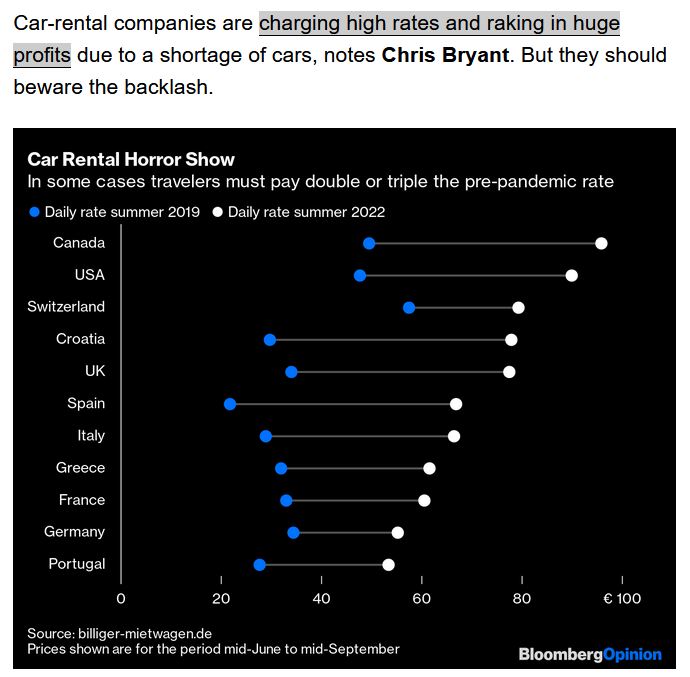 |
Comments on “Quantifiable urine glyphosate levels detected in 99% of the French population, with higher values in men, in younger people, and in farmers” by William Reeves, John L. Vicini, John T. Swarthout, Bruce M. Young & Pamela K. Jensen, scientists employed by Bayer Crop Science, in Environmental Science and Pollution Research (2022)
Grau et al. reported quantifiable levels of glyphosate in 99.8% of urine samples collected in France between 2018 and 2020. Conclusions about these data rest on the reliability of the analytical method and the ability to put the data into the context of safety standards. Rather than demonstrating evidence of a health concern for the French population, data from the study confirm that human exposures to glyphosate are well below safety thresholds established by regulatory authorities in Europe.
Grau et al. relied on an ELISA method to estimate glyphosate concentrations in urine samples. This method was designed for testing glyphosate in water and is meant to serve as a screening tool to identify samples for more robust quantitative analysis. The ELISA does not provide a clear confirmation of a specific concentration (Vicini et al. 2021)., and as the authors admit, tends to overestimate glyphosate levels in urine.
Additionally, the publication is missing key information that would have helped readers understand whether the reported values indicate a health concern. Other publications presenting human urinary glyphosate data provide estimates of daily exposure and compare those estimates to allowable exposure levels (Niemann et al. 2015; Solomon 2020; Vicini et al. 2021). These comparisons consistently demonstrate that human exposures to glyphosate are well below established safety thresholds.
Grau et al. reported the highest mean urinary glyphosate concentration was 2.05 ± 1.29 ng/ml for study participants under the age of 16 years. Taking this largest mean value plus three times the standard deviation gives an estimated upper end concentration of 5.92 ng/ml. Assuming a 30-kg child with a 1-L/day urinary volume results in an estimated intake of 0.000987 mg/kg-body weight/day or 0.2% of allowable exposures in the European Union (currently 0.5 mg/kg/day). This value is based on 20% bioavailability (EFSA 2015). Even using the 1% bioavailability value Grau et al. cite, the estimated exposure corresponding to the highest urinary concentration would still be 4.0% of allowable EU exposures for glyphosate.
It is important to note that Grau et al. did not disclose that the sponsor of their study and the employer of three authors, Association Campagne Glyphosate, advocates for a ban on the use of glyphosate-based herbicides in France. This information would have provided readers with important context regarding the purpose of the study and publication. This letter was drafted by scientists employed by Bayer Crop Science, a manufacturer of glyphosate. The method used to calculate exposure was first published by Niemann et al. (2015).
See springer.com
Securing homes in American agglomerations (as in France)
| 09 - 09/06/2022 | 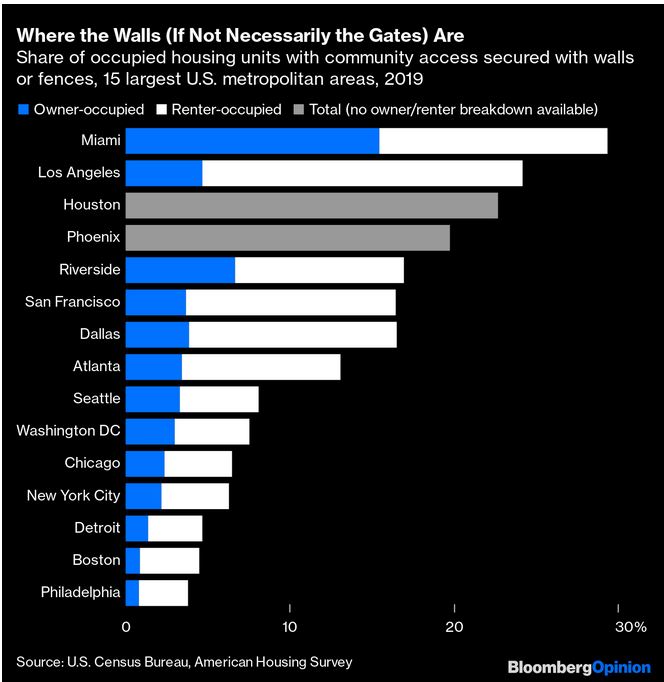 |
Perspective: The EU’s carbon-neutral farm plan masks the real impact, by Amanda Zaluckyj, The Farmer’s Daughter USA
.../...
Farm to Fork’s goals all lead to one thing: lower food production. Based on its own analysis, the U.S. Department of Agriculture’s Economic Research Service believes the strategy will reduce European agricultural production between 7 and 12 percent. There’s no question cutting inputs decreases yields, as does organic agriculture.
But here’s the rub: Europeans still need to eat. Just because inputs are cut and farmland is taken out of production doesn’t mean the demand for food also falls. So where will that food come from? Other parts of the world, of course, including places where virgin rainforests are bulldozed over to make way for more farmland.
And that’s the grand irony of Farm to Fork: It’s just a sleight of hand. The EU isn’t actually going carbon neutral; it’s just exporting its carbon emissions to other parts of the world. Unfortunately, that likely means we’ll continue to lose rainforests, despite the fact that they play such a pivotal role in regulating Earth’s climate.
That’s one reason I’m so passionate about using science, technology, and innovation to make our current production methods more sustainable. Those tools are the reason we can feed more people using the same amount of land, we can reduce our use of pesticides and fertilizers, and how we continue to increase overall yields. These aren’t just magic tricks to make us feel like we’re making a difference; it’s real progress.
But as long as environmental activists continue to fight against productional advancements, we’ll see additional environmental degradation. It’s time to abandon those backward perspectives and start looking to a more sustainable future. Otherwise, we’ll eventually find ourselves in a time where we can only hope that quicksand and fire safety are our biggest concerns.
See agdaily.com
Agricultural area per inhabitant in 2019 in different European countries
Voir bfs.admin.ch
| 10 - 09/06/2022 | |
Why your ability to repair a tractor could also be a matter of life and death, by John Naughton
US farmers’ struggles for the right to fix their own, now highly computer-controlled equipment, have implications for us all.
It was one of the few pieces of cheery news to emerge from the war in Ukraine. Russian looters, no doubt with the assistance of Russian troops, stole 27 pieces of John Deere farm equipment, worth about $5m, from a dealership in Melitopol. The kit was shipped to Chechnya, where a nasty surprise awaited the crooks. Their shiny new vehicles had, overnight, become the world’s heaviest paperweights: the dealership from which they had been stolen had “bricked” them remotely, using an inbuilt “kill-switch”.
This news item no doubt warmed the cockles of many a western heart. But it would have raised only hollow laughs from farmers in US states who are customers of John Deere and are mightily pissed off, because although they have paid small fortunes (up to $800,000 apparently) for the firm’s machinery, they are unable to service or repair them when they go wrong. These gigantic vehicles are no longer purely mechanical devices, but depend on lots of electronic control units (ECUs) to operate everything from the air conditioning to the driver’s seat to the engine. The ICUs run software that is essential to the operation, maintenance and repair of the machine. But only John Deere has access to that computer code and without employing a company technician the tractor’s software won’t even recognise (let alone allow) replacement parts from another manufacturer.
.../...
This isn’t just about consumer electronics or even farmers’ rights by the way, as we discovered during the early, panic-stricken months of the pandemic. Then, hospitals urgently needed to repair or service critical medical equipment, but found that sometimes manufacturers wouldn’t provide proprietary repair manuals or supply replacement parts. In March 2020, for example, an Italian hospital was unable to obtain valves for its ventilators from their manufacturer. Volunteers designed and 3D-printed 100 replacements at a cost of a dollar each. In normal times, those engineers might well have been prosecuted by the manufacturer for infringing its intellectual property rights. So sometimes the right to repair isn’t just a geeky obsession but a matter of life or death.
See theguardian.com
The Marshes from Burgh Castle, Norfolk, by John Alfred Arnesby Brown (1866–1955), Norfolk Museums Service
| 09 - 09/06/2022 |  |
Climate alarmism thrives on simple stories.
Sea levels are rising, and since many Pacific and Indian Ocean islands are small, scattered, and low-lying, an avalanche of “climate refugees” seems inevitable.
However, reality is more complicated. While sea level rise is a problem for island nations, many of them are actually growing in land area thanks to land reclamation and natural siltation.
See humanprogress.org
Mary Astell and Mary Wollstonecraft, two of the earliest feminist philosophers.
While their ideas did not spark immediate reforms, they provided the intellectual foundation for the suffragette and feminist movements, which continue around the world to this day.
See humanprogress.org
Overpopulation continues to capture public attention, but underpopulation is a far greater and more plausible threat to progress
If current trends continue, the world population will age and eventually shrink, meaning we will have to adapt to smaller workforces, fewer innovators, and less economic dynamism.
 |
The Riverbank, by John Alfred Arnesby Brown (1866–1955), Guildhall Art Gallery
| 10 - 09/06/2022 | 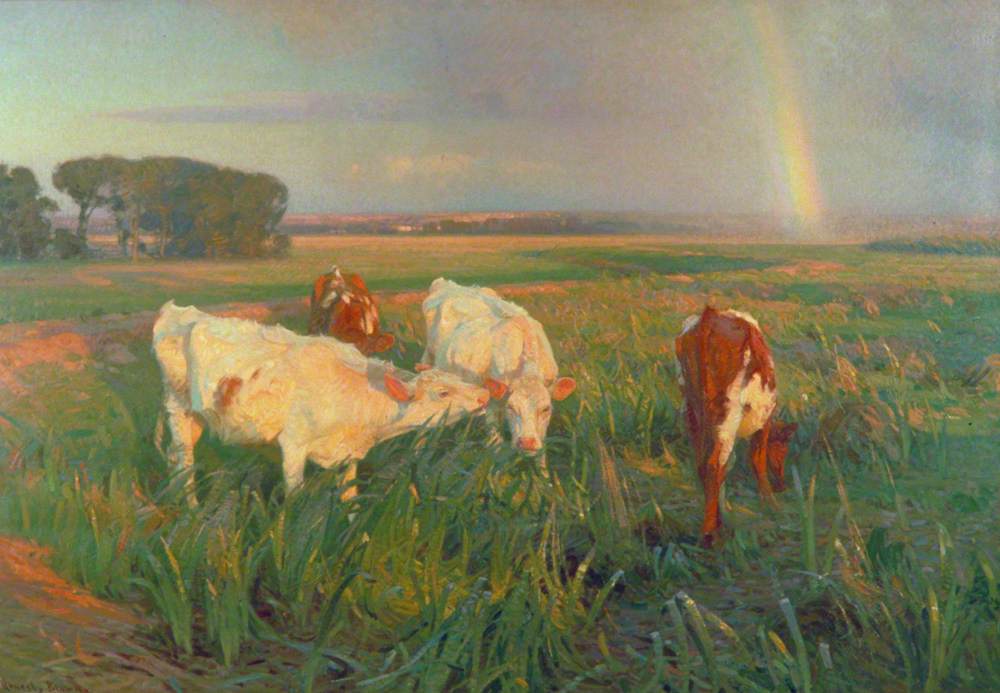 |
Perspective: USDA pushing farmers toward organic will make supply chains far worse, by Amanda Zaluckyj, The Farmer’s Daughter USA
The National Organic Program is about a label and marketing, not an assessment of safety or quality. A resilient food system isn't built on a sticker.
.../...
USDA Secretary Tom Vilsack defended this funding for organic farmers by suggesting it would somehow make farmers more profitable. In theory, organic products sell for a higher price. Vilsack believes that means farmers will see a larger portion of the sale price.
Agriculture Secretary Tom Vilsack (right) met with others in an Ohio supermarket to drum up support for his plan to transform food system. (Image by USDA)
That’s a mighty big assumption that, to my knowledge, isn’t supported by any research or other evidence. Even if organic products fetch a higher retail price, organic yields are significantly lower than conventionally grown food. If you have less to sell, the price has to be higher to make the same money. And if the USDA successfully adds hundreds of millions of dollars in support, all those new organic farms will flood the market and drive prices down anyway.
And while we’re on the subject of lower yields, I can’t fathom why the USDA would champion the organic program to shore up supply chains. During the next global crisis, I want American farmers to grow more food, not less. The National Organic Program is about a label and marketing, not an assessment of safety, quality, or best practices. You don’t create a resilient food system based on a sticker.
Instead we need a food system that is abundant, adaptive, responsive, and progressive. Not one stuck in a marketing scheme that arbitrarily decides what’s “synthetic” and what’s “natural.” We can achieve that by opening up new markets, reducing the cost of modern equipment and technology, stabilizing our supplies of pesticides and fertilizers, and investing in new research.
Funding transitioning farmers doesn’t invest in the right things. In fact, it’s so wildly random that it seems more like a pay off to special interests than a solution to our challenges.
With record inflation and quickly rising fuel prices, we’re possibly sitting on the brink of the next economic crisis. Farmers need the USDA to address those economic hurdles now. Secretary Vilsack better start paying attention before it’s too late.
See agdaily.com
Number of farms in Switzerland (in thousands)
Voir bfs.admin.ch
| 11
- 09/06/2022 |
|
Farm Robots Will Solve Many of Our Food Worries
Machines bristling with cameras and controlled by artificial intelligence are bringing supernatural precision to weeding, harvesting and fertilizing.
Autonomous tractors are only the beginning? By Amanda Little, 2 June 2022
Amanda Little is a Bloomberg Opinion columnist covering agriculture and climate. She is a professor of journalism and science writing at Vanderbilt University and author of “The Fate of Food: What We'll Eat in a Bigger, Hotter, Smarter World.” @littletrip
A robot army is beginning its march across rural America, promising to transform the future of food. Twenty-five intelligent machines were dispatched last month to the Midwest and the Mississippi Delta, where they will advance over newly planted fields at 12 miles an hour, annihilating baby weeds.
Produced by John Deere and created by the startup Blue River Technology, these robotic weeders look much like standard industrial sprayers at first glance, but each is rigged with an intricate system of 36 cameras and a mass of tiny hoses. They use computer vision to distinguish between crops and weeds and then deploy with sniper-like precision tiny jets of herbicide onto the weeds — sparing the crop and ending the common practice of broadcast-spraying chemicals across billions of acres.
The "See and Spray Ultimate" robots are expensive, enormous, wildly complex machines currently accessible only to industrial-scale farmers, but within a few years their impact on the environment and human health could be nothing short of spectacular. They are in the vanguard of a wave of reimagined agricultural equipment that will help farmers produce more food on less land with radically reduced chemical applications.
Intelligent machines can treat plants individually, eventually applying not just herbicides but pesticides, fungicides and fertilizers on a plant-by-plant — rather than field-by-field — basis. This kind of hyper-precision may do more than ratchet down agrochemical usage, also allowing for more diversity and crop-mixing on fields, so that larger farms can begin to mimic natural systems. Meanwhile, robotic planters and combines are already showing yield improvements of up to 2%, and robotic harvesters could eventually alleviate increasingly grueling farm work and labor shortages.
Robots on farms, for all their environmental and ethical promise, raise plenty of concerns — some valid, others spurious. They will add cost and complexity to farming equipment, making farmers increasingly reliant on Big Ag companies like John Deere. In the beginning, they will strengthen the dominance of large industrial operators while eluding the local small and midsize farmers who are essential to sustainable and resilient food systems.
So as the era of artificial intelligence in farming dawns, manufacturers, the Biden administration and investors should be thinking about how to develop this market responsibly. Funding should be steered to the development of smaller, more affordable machines while also supporting a rental economy that enables local and midsize farmers to lease, if not own, this next-generation equipment. The US Department of Agriculture should also create rebate and tax-credit programs to help farmers affordably trade out old machinery for new.
See and Spray is one of seven AI products that John Deere now has in development, including robotic planters, self-driving tractors and combines that meticulously separate wheat from chaff. All are equipped with dozens of cameras and algorithm-crunching data processors that examine, analyze and measure every plant and seed on a field.
“We’re doubling down, tripling down on investment in robotics and machine learning,” Jorge Heraud, Deere’s vice president of automation and machine autonomy, told me. Having grown up working on (and weeding) his grandparents’ tomato farm in Peru, Heraud founded Blue River Technology, which Deere acquired in 2017 along with its See and Spray prototype for $305 million. In five years, Heraud has helped grow Deere’s AI team to 400 people from 50.
Many skeptics I’ve talked with question whether this equipment will ever be widely adopted. Deere says it already has more demand than it’s ready to meet: Heraud decided to release only 25 in its first fleet because the company is still honing the financing and servicing model. Currently, Deere is charging an upfront price that they won’t disclose (it’s at least the cost of a standard sprayer of this size, about $500,000), plus an ongoing per-acre fee that may be charged monthly or annually and includes software upgrades and maintenance. Heraud plans to increase the fleet by a factor of 10 annually, so that by 2025 the company will have thousands of robotic weeders on the market.
The worry that intelligent machines will simply make industrial farms bigger and farmers lazier, less responsible stewards of the land is unfounded. These kinds of advanced technologies have extraordinary potential to help farmers improve the health of their soil and the quality of the food they produce by drastically reducing the use of harmful chemical herbicides such as glyphosate, Dicamba and 2,4-D.
Twenty billion gallons of herbicide are currently applied annually by sprayers worldwide across one billion acres of farmland. When See and Spray technology is integrated into all sprayers sold by the company, which Heraud says could happen within a decade, the volume of herbicide deployed on these farms could plummet to four billion. Future generations of the equipment may also be able to significantly curtail the use of fossil fuel-derived fertilizers, which, when overapplied, fuel climate change.
Governments can help allay concerns with incentives: The California Air Resources Board provides a helpful model, offering farmers rebates for upgrading their existing machinery to models with cleaner engines. The USDA and investors can also encourage the development of a rental economy by incentivizing and funding young companies like Nutrien Ag Solutions in the US and Hello Tractor in Africa that function like the Ubers of agriculture, enabling small and midsize farmers to lease or acquire fractional ownership of next-generation farm equipment without having to maintain it or learn the technology.
Venture capital can be directed to support new players in the AI market. One young startup, Earthsense, is developing robots the size of microwaves that rove around farms removing weeds. Deere is also working on smaller, more affordable machines.
See bloomberg.com
Support allocated to agriculture
| 12 - 02/06/2022 | 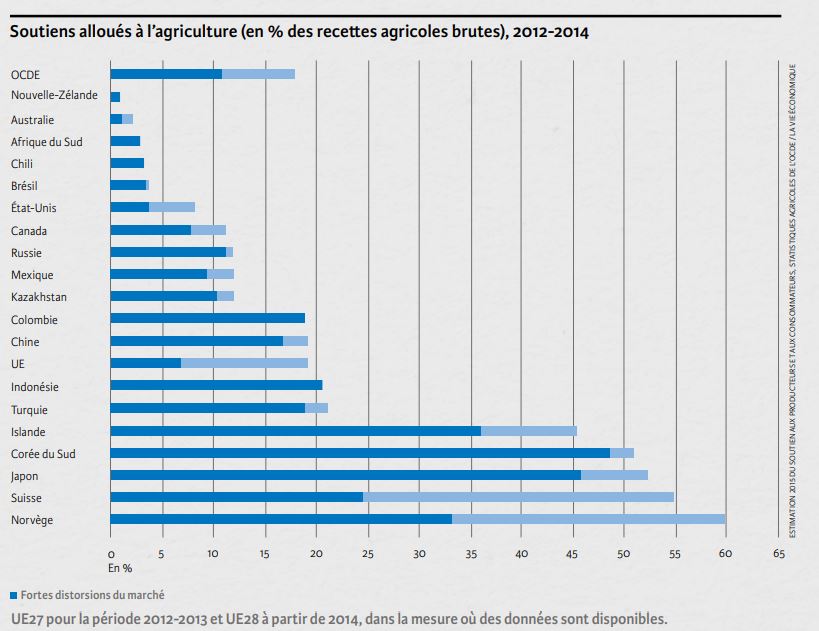 |
Even Abraham and Moses spent much of the Torah arguing with God... Constant dispute
A Jewish man goes sailing but ends up shipwrecked on a desert island. Years later, he’s found, but the man’s rescuers want to know why he built a structure with a Star of David on it.
The man replies, “That’s the synagogue where I pray.”
They then inquire about a separate structure he’d built, also with a Star of David.
“Ah, that,” says the man, “is the synagogue I never set foot in.”
| |
The distribution of this efita newsletter is sponsored by vitisphere.com
Please, contribute to the content of your efita newsletter, and advertise your events, new publications, new products and new project in this newsletter. Without your support, it will not survive!
Contact: Guy WAKSMAN
E-mail: guy.waksman(a)laposte.net
To read this newsletter on our web site
See Efita
The archives of this newsletter
See Efita
Do not miss the Virus Jokes in English and French
About the EFITA mailing list
You can use the efita moderated list (> 15000 subscribers) to announce any event / product / web site / joke (!) related to IT in agriculture, environment, food industry and rural areas.
If you want to subscribe a friend, please fill in his form.
If you do not wish to receive our messages, please fill in the following form...



